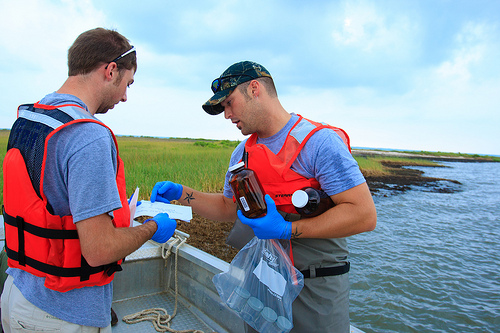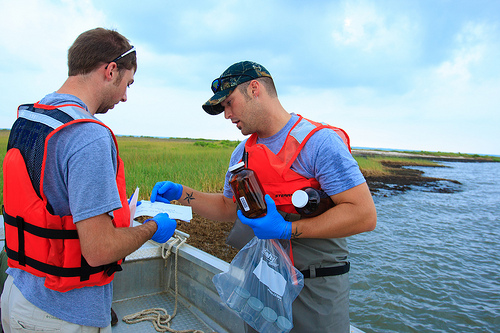 Scientists collecting sediment samples for the EPA.Photo: BP AmericaThe “Where’s the oil?” rant made for good headlines. But two tougher questions about the Gulf Coast are floating out there and neither will get an answer any time soon: Will life under the sea be permanently changed by the massive amount of oil and dispersants dumped into it? And, will American consumers ever eat anything that’s been living in all that goo?
Scientists collecting sediment samples for the EPA.Photo: BP AmericaThe “Where’s the oil?” rant made for good headlines. But two tougher questions about the Gulf Coast are floating out there and neither will get an answer any time soon: Will life under the sea be permanently changed by the massive amount of oil and dispersants dumped into it? And, will American consumers ever eat anything that’s been living in all that goo?
Chain of fuels: Scientists have begun wrestling with the first one, but they fear a replay of what happened after the disastrous Ixtoc I well explosion off the Mexican Gulf Coast in 1979. Once the beaches were clean, the funding dried up. Ana Campoy writes about it in the Wall Street Journal:
To be sure, scientists have a vested interest in seeking as much money as possible because of the job security and compensation that can accompany research grants. But many of them said more research on Ixtoc I years ago would be helpful now. A key question that scientists are still trying to answer: What happened to the oil that didn’t burn off, evaporate, or get collected?
Some researchers aren’t waiting for federal grants. A crew from the University of South Florida is already out in the Gulf and will be spending the rest of week collecting samples. Rob Shaw, of Tampa Bay Online, writes:
… the scientists will be checking sources all along the food chain — the bacteria that eat the oil, the plankton that feed on the bacteria, the fish that feed on the plankton — to see what kind of effect the oil and the dispersants used to fight the spill might have.
Jeff Goodell, contributing editor for Rolling Stone, says we should be less worried about the dispersants than their effect on the oil. As he told NPR’s Liane Hansen:
The real problem is that the dispersants break the oil up into much smaller particles that sink down into the water column of the Gulf. And we have to remember that this oil is coming up from a mile deep, and so there’s a lot of life in the Gulf there from the bottom to the top. And it’s sending this oil out in smaller sorts of particles that can be more easily sort of taken up by organisms, from coral reefs all the way up to killer whales …
Chicken of the sea? That leads to the second question — what’s the effect on Gulf seafood? The U.S. Food and Drug Administration tried to reassure everyone Friday, sending out a letter saying it’s highly unlikely dispersants will get into the food chain. That’s a start. But as chefs and restaurant owners at the Great American Seafood Cook-Off in New Orleans acknowledged, they’ve been slimed, and they want help cleaning up their image:
Ralph Brennan, who owns a slew of popular New Orleans restaurants, said he is worried that BP and the federal government will try to back off since the immediate crisis is over.
“We really need to have a system in place to monitor this for several years, to be sure that the seafood is going be safe in the long term, and then we need to market that,” Brennan said. “I think one of the things we ought to do is start with how much BP is spending now on their own PR campaign and ask them to match that for us, and it might be a good start.”
What brown can do to you: Over the weekend Enbridge, Inc. turned up the source of the summer’s other spill — more than 800,000 gallons of oil dumped into Michigan’s Kalamazoo River. Enbridge, the owner of the failed pipeline, says the cause of the spill was a five-foot long rip. Not nearly as dramatic as the fiery explosion and drenching of the Gulf, but as Kari Lydersen and David Fahrenthold wrote in the Washington Post, there are disturbing parallels:
… other plot points are eerily similar: A large company with safety violations. Regulators who didn’t act fast enough. Claims centers. Containment boom. Broken equipment that everybody’s waiting to examine.
And just like the BP debacle raised huge red flags about deep-sea drilling, the Michigan spill is setting off alarms about the destructive and dangerous process of extracting oil from the tar sands of Canada, then pumping it through miles of pipelines to refineries in the U.S. Writing in the Los Angeles Times, Michael Brune and Anne Woiwoode, of the Sierra Club, describe what’s involved before the oil even gets into the pipes:
To get tar-sands oil, you first clear-cut ancient boreal forest. Then you expend jaw-dropping quantities of energy and water to grind up the earth and extract tiny bits of crude. The process leaves behind toxic lakes so big they can be seen from space.
Make it stop: Even when Congress isn’t dealing with climate and energy, it manages to muck things up. The latest? House members return this week to vote on a Senate version of a bill that would give $26 billion to the states to avoid teacher layoffs and pay for Medicaid. Guess what they’re cutting to help cover the cost? About $1.5 billion in loan guarantees for renewable energy projects. Majority Leader Harry Reid (D-Nev.) swears it’s just a temporary snag and that he’ll find a way to replace the renewables money. But as Coral Davenport writes in Politico‘s Morning Energy blog:
… sources close to the solar and wind lobbying arms say there’s no coherent legislative strategy as to how they’ll get the funding back. So the question is, how will Reid and Pelosi restore the funding before elections — and what will the fallout from the clean energy industry look like if they don’t?
This on a day when China reveals that it plans to spend $738 billion on renewable energy over the next 10 years. Oh, yeah and that it will shut down more than 2,000 energy-sucking plants.
Something’s blowin’ in the wind. And it doesn’t feel much like answers.


